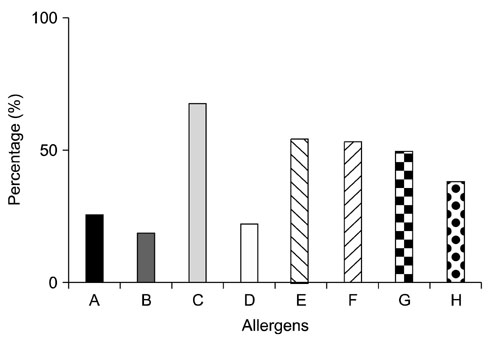J Vet Sci.
2011 Sep;12(3):287-290. 10.4142/jvs.2011.12.3.287.
Common allergens of atopic dermatitis in dogs: comparative findings based on intradermal tests
- Affiliations
-
- 1BK21 Basic & Diagnostic Veterinary Specialist Program for Animal Diseases and Department of Veterinary Internal Medicine, College of Veterinary Medicine, Konkuk University, Seoul 143-701, Korea. parkhee@konkuk.ac.kr
- KMID: 1067402
- DOI: http://doi.org/10.4142/jvs.2011.12.3.287
Abstract
- Intradermal tests were performed on 58 dogs diagnosed with atopic dermatitis from 2004~2008 at the Veterinary Medical Teaching Hospital of Konkuk University, Korea. To compare the allergen distribution observed in the present investigation to the results from other studies conducted in Korea and elsewhere, the allergens were grouped according to their kinds. There was no significant difference in gender distribution among the dogs. The most common breeds among the 58 dogs were Maltese (n = 11) and Shih-tzu (n = 11). The average age was 4.8 years. The most frequently produced a positive reaction on the intradermal tests was mold (67.3%) followed by house dust (54.5%) and house dust mites (49.1%). The present study found a low distribution of dogs allergic to various outdoor allergens compared to studies performed in other countries; this may reflect differences in living conditions for dogs living in Korea.
Keyword
MeSH Terms
Figure
Cited by 1 articles
-
Sensitization rates of causative allergens for dogs with atopic dermatitis: detection of canine allergen-specific IgE
Min-Hee Kang, Ha-Jung Kim, Hye-Jin Jang, Hee-Myung Park
J Vet Sci. 2014;15(4):545-550. doi: 10.4142/jvs.2014.15.4.545.
Reference
-
1. August JR. The reaction of canine skin to the intradermal injection of allergenic extracts. J Am Anim Hosp Assoc. 1982. 18:157–163.2. Chae JS, Adjemian JZ, Kim HC, Ko S, Klein TA, Foley J. Predicting the emergence of tick-borne infections based on climatic changes in Korea. Vector Borne Zoonotic Dis. 2008. 8:265–275.
Article3. Codner EC, Lessard P. Comparison of intradermal allergy test and enzyme-linked immunosorbent assay in dogs with allergic skin disease. J Am Vet Med Assoc. 1993. 202:739–743.4. De Weck AL. What can we learn from the allergic zoo? Int Arch Allergy Immunol. 1995. 107:13–18.
Article5. Hill PB, DeBoer DJ. The ACVD task force on canine atopic dermatitis (IV): environmental allergens. Vet Immunol Immunopathol. 2001. 81:169–186.
Article6. Jang WR, Nahm CH, Kim JH, Lim DH, Jang TY, Moon YS, Kim JJ. Allergen specific IgE measurement with polycheck allergy: Comparison of three multiple allergen simultaneous tests. Korean J Lab Med. 2009. 29:465–472.
Article7. Lian TM, Halliwell REW. Allergen-specific IgE and IgGd antibodies in atopic and normal dogs. Vet Immunol Immunopathol. 1998. 66:203–223.
Article8. Masuda K, Sakaguchi M, Fujiwara S, Kurata K, Yamashita K, Odagiri T, Nakao Y, Matsuki N, Ono K, Watari T, Hasegawa A, Tsujimoto H. Positive reactions to common allergens in 42 atopic dogs in Japan. Vet Immunol Immunopathol. 2000. 73:193–204.
Article9. Moon KW, Byeon SH, Chio DW, Kim YW, Lee JH, Lee EI. Exposure assessments on biological contaminants in homes of allergy patients-bacteria, fungi, house dust mite allergen and endotoxin. J Environ Health Sci. 2005. 31:120–126.10. Nelson HS. The importance of allergens in the development of asthma and the persistence of symptoms. J Allergy Clin Immunol. 2000. 105(6 Pt 2):S628–S632.
Article11. Olivry T, DeBoer DJ, Griffin CE, Halliwell REW, Hill PB, Hillier A, Marsella R, Sousa CA. The ACVD task force on canine atopic dermatitis: forewords and lexicon. Vet Immunol Immunopathol. 2001. 81:143–146.
Article12. Omenaas E, Bakke P, Eide GE, Elsayed S, Gulsvik A. Serum house-dust-mite antibodies and reduced FEV1 in adults of a Norwegian community. Am J Respir Crit Care Med. 1995. 152:1158–1163.
Article13. Park S, Ohya F, Yamashita K, Nishifuji K, Iwasaki T. Comparison of response to immunotherapy by intradermal skin test and antigen-specific IgE in canine atopy. J Vet Med Sci. 2000. 62:983–988.
Article14. Reedy LM, Miller WH Jr, Willemse T. Allergic Skin Disease of Dogs and Cats. 1997. 2nd ed. Philadelphia: Saunders;83–115.15. Scott DW, Miller WH Jr, Griffin CE. Muller and Kirk's Small Animal Dermatology. 2000. 6th ed. Philadelphia: Saunders;584–589.16. Sener O, Kim YK, Ceylan S, Ozanguc N, Yoo TJ. Comparison of skin tests to aeroallergens in Ankara and Seoul. J Investig Allergol Clin Immunol. 2003. 13:202–208.17. Vollset I. Atopic dermatitis in Norwegian dogs. Nord Vet Med. 1985. 37:97–106.18. Weiss ST, O'Connor GT, DeMolles D, Platts-Mills T, Sparrow D. Indoor allergens and longitudinal FEV1 decline in older adults: the normative aging study. J Allergy Clin Immunol. 1998. 101(6 Pt 1):720–725.
Article19. Willemse T. Atopic skin disease: a review and a reconsideration of diagnostic criteria. J Small Anim Pract. 1986. 27:771–778.20. Zur G, Ihrke PJ, White SD, Kass PH. Canine atopic dermatitis: a retrospective study of 266 cases examined at the university of California, Davis, 1992-1998. Part I. Clinical features and allergy testing results. Vet Dermatol. 2002. 13:89–102.
Article
- Full Text Links
- Actions
-
Cited
- CITED
-
- Close
- Share
- Similar articles
-
- Allergens Causing Atopic Diseases in Canine
- Comparison of rapid screening immunoassay and intradermal test for canine atopic dermatitis
- Sensitization rates of causative allergens for dogs with atopic dermatitis: detection of canine allergen-specific IgE
- The study of prick test results and serum IgE levels in patients with atopic dermatitis
- Comparison of MAST Chemiluminescent Assay(MAST-CLA) with Skin Prick, Test in Patients with Atopic Dermatitis


